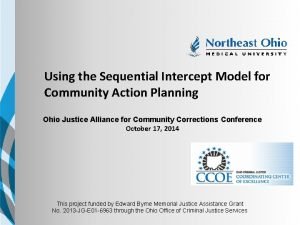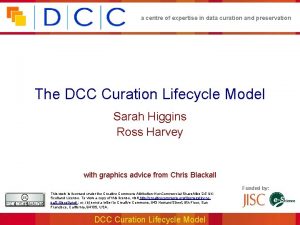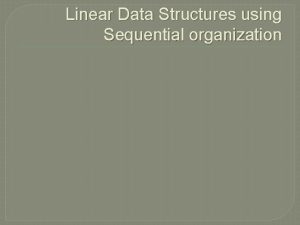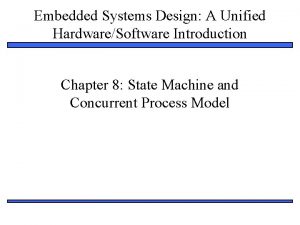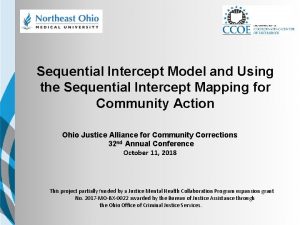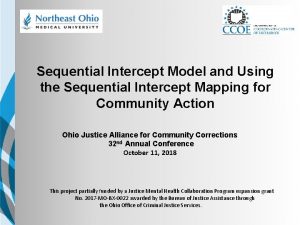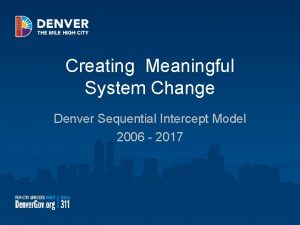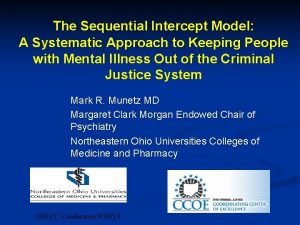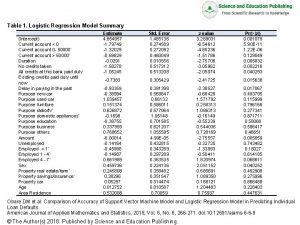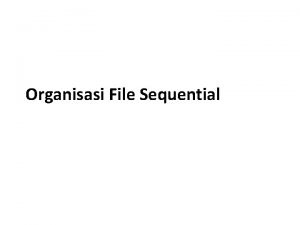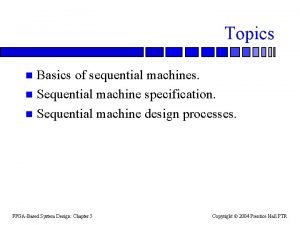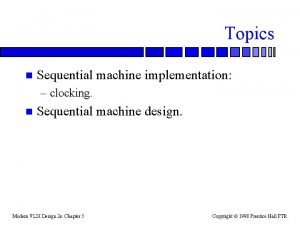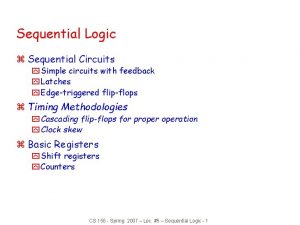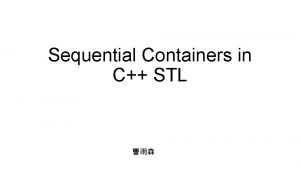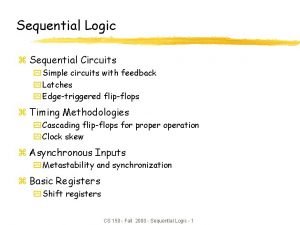Using the Sequential Intercept Model for Community Action






























































- Slides: 62

Using the Sequential Intercept Model for Community Action Planning NEOMED TEMPLATE Ohio Justice Alliance for Community Corrections Conference October 17, 2014 This project funded by Edward Byrne Memorial Justice Assistance Grant No. 2013 -JG-E 01 -6963 through the Ohio Office of Criminal Justice Services

PRESENTERS: Mark R. Munetz, M. D. Criminal Justice Coordinating Center of Excellence Northeast Ohio Medical University Ruth H. Simera, M. Ed. , LSW Criminal Justice Coordinating Center of Excellence Northeast Ohio Medical University

ADULT CORRECTIONAL POPULATION 1980 – 2011 (BUREAU OF JUSTICE STATISTICS) 4500000 4000000 3500000 3000000 2500000 Jail 2000000 State Prison 1500000 Parole 1000000 500000 0 1980198219841986198819901992199419961998200020022004200620082010

PREVALENCE OF BEHAVIORAL HEALTH DISORDERS IN CORRECTIONS POPULATION Total Corrections Population 70% with Substance Use Disorder (SUD) 50% Dependent Substance Use Disorders 31% Mental Illness • Prevalence fairly consistent across prison, jail and community corrections • Rates of dependency and mental illness higher among women 17% SMI 72% of SMI with SUD Slide courtesy of Fred Osher, M. D.

OVER-REPRESENTATION OF PEOPLE WITH MENTAL ILLNESS: THE OHIO STORY • In Ohio prisons • Total inmates = 50, 117 (4/1/2013) – 9554 inmates on the mental health caseload (~19%) • Unclear how many have a serious and persistent mental illness (SPMI) – Ohio Department of Mental Health and Addiction Services completes approximately 1800 linkage packets for persons identified as SPMI per year • In Ohio psychiatric hospitals – 1022 individuals (2/28/2013) • 60% are “forensic patients” – Not Guilty by Reason of Insanity (NGRI) – Incompetent to Stand Trial (IST) – Competency or sanity evaluations

“Unsequential” Model Initial Hearings Arrest Jail Mental Health Substance Abuse Dan Abreu Prison

CRIMINAL JUSTICE COORDINATING CENTER OF EXCELLENCE (CJ/CCOE) • In May 2001 the Summit County ADM Board was designated by Ohio. MHAS to be a CCo. E to help in the state-wide elaboration of Jail Diversion programs • Northeast Ohio Medical University (NEOMED) operates the Center

A SYSTEMATIC APPROACH TO THE CRIMINALIZATION PROBLEM • There is no single solution to the problem we are calling “criminalization of people with mental illness” – People move through the criminal justice system in predictable ways – The problem must be attacked from multiple levels – The Sequential Intercept Model

SEQUENTIAL INTERCEPTS Best Clinical Practices: The Ultimate Intercept I. Law Enforcement/Emergency Services II. Post-Arrest: Initial Detention/Initial Hearings III. Post-Initial Hearings: Jail/Prison, Courts, Forensic Evaluations & Forensic Commitments Munetz & Griffin: Psychiatric Services 57: 544– 549, 2006 IV. Re-Entry From Jails, State Prisons, & Forensic Hospitalization V. Community Corrections & Community Support

SEQUENTIAL INTERCEPT MODEL

CROSS INTERCEPTS • The GAINS Center has identified several system-level approaches relevant across all the intercepts. – Encourage and support collaboration among the stakeholders – Many of the cross intercept approaches are part of what we called the “ultimate intercept” • For example, supported housing, education and employment, peer support and other EBPs • Services which are culturally competent, gender specific and trauma informed • Services which address the specific needs of veterans • Recent attention to criminogenic risks and needs

Sequential Intercept Mapping Problem: In multiple systems; expensive, high service users Solution: Cross-system Coordination & Collaboration

Focus • Men and women with… – Serious mental illness, and often § Co-occurring substance use disorders – Involved in the criminal justice system

Goals § § Promote & support recovery Provide safety, quality of life for all Keep out of jail, in treatment Provide constitutionally adequate treatment in jail § Link to comprehensive, appropriate, and integrated community-based services

Objective - Collaboration Substance Abuse Criminal Justice

Tasks §Map the local system §Identify gaps §Build an action plan §Build collaborations

Challenges to Collaboration Funding “silos” Limited resources System “cultures”

Benefits of Effective Collaboration Community Collaboration + Services Integration = service retention stability in the community public safety

Additional Strategies §Shared vision & direction § Evidence-based & promising practices § Funds: creative use § Data


• Approximately 75% of the group should be top and middle level administrators • About 25% should be front line staff and peers/consumers or family with lived experiences


COMMUNITY Dispatch 911 Local Law Enforcement Intercept 1 Law enforcement / Emergency services Arrest

Memphis Crisis Intervention Team Model (CIT) • 1988 introduced as vital component to the community’s demand for safer police response following worst outcomes of police shootings • First responders, mental health system, and consumer/family collaborations and partnerships key to making changes in existing systems • Some communities have no where to take people other than jail. Need for law enforcement training for helping individuals with mental illness Intercept I

Intercept 1: Intercepting at First Contact Police & Emergency Services (Deane, et al, 1999) • Police-based specialized police response – Front line police response – Specialized training/support system – Example: Memphis Crisis Intervention Team (CIT) • Police-based specialized mental health response – MH professionals employed by police dept. – Example: Community Service Officers in Birmingham AL • Mental Health-based specialized response – Mobile crisis teams – Examples: Montgomery County Emergency Services (PA); Knoxville TN; Butler County, Ohio Intercept I

Specialized Crisis Response Sites: Basic Principles • • Identifiable, central drop-off for law enforcement “Police-friendly” policies and procedures Streamlined intake “No refusal” policy Legal foundations Innovative and extensive cross-training Linkages to community services – Even for those who do not meet criteria for inpatient commitment (Steadman, et al, 2001)

CIT • A police officer safety program • A mental health consumer safety program • A unique community partnership – A different way of doing business for law enforcement, the mental health system, consumers and their families • A pre-arrest jail diversion program • A civil liability reduction program Intercept I

Crisis Stabilization Units Local Law Enforcement Jail Releases Other COMMUNITY Pre-booking Jail Diversion Intercept 1 Law enforcement / Emergency services - Transition Service Linkage: ICM/ACT EBP’s Peer Bridging Medical f/u Trauma Specific Services Jail linkage Other Assistance: Medication Access Benefits Housing Information Sharing 28

Intercept 2 First Appearance Court Arrest Initial Detention Initial detention/Initial court hearings

Characteristics of Intercept 2 Diversion Legal Criteria: • Misdemeanor • Low history of violence • Multiple Arrests Clinical Factors: • Serious and Persistent Mental Illness • Difficult to engage • High need • Failed Treatment history • Acute care • Needs civil commitment Compared to Mental Health Court, can serve more people with fewer court staff, resources, sanctions and jail time.

Promising and Best Practices § Role of Pretrial Services § Brief Jail Mental Health Screen § Use of management information systems to identify and re-link to services § Immediate referrals to community services § Follow-up into the community

Intercept 3 Jails/Courts Specialty Courts Other Court Programs Jail-Based: Mental Health & Substance Abuse Services

Intercept 3: Jails and courts § Ohio Specialized Dockets: § Mental Health Courts Drug Courts § OVI/DUI Courts Domestic Violence Courts § Child Support Enforcement Courts § Re-entry Courts Sex Offender Courts § Veterans Courts § In-jail services: § Identification / screening § Access to mental health / substance abuse services (medications, etc. ) § Communication with previous services as appropriate

Using Criminal Charges to lead to Treatment § Diversionary or Treatment in Lieu --- Generally pre-adjudication contracts with judges to participate in treatment; Conviction is not recorded § Example: § Prosecutor holds charges in abeyance based on agreement to enter treatment under supervision of mental health court; Plea is entered but adjudication is withheld § Post-Plea Based --- Adjudication occurs but disposition or sentence is deferred § Example: § Guilty plea is accepted; Sentence is deferred § Probation Based § Example: § Conviction with treatment as a term of probation plus suspended jail sentence Griffin, Steadman, & Petrila 2002

Intercept 4 Prison Reentry Jail Reentry

The Back Door: Linkages Between Institutions and the Community Intercept 4

Post Release Risk of Death § 30, 237 Washington State Prison releases § 443 died during average follow up of 1. 9 years § Death rate 3. 5 times higher than general population § Within first 2 weeks of release, death rate 12. 7 times higher for inmates with SMI § Drug overdose leading cause of death, then heart disease, homicide and suicide (New England Journal of Medicine, 2007)

Brad H. Case • Class action filed by 5 inmates released from Riker’s Island Jail in NYC • Alleged that the City violated state mental hygiene law and agency regulation in releasing inmates with mental illness from jail without discharge planning services • In July of 2000, the NYS Supreme Court ordered NYC to provide adequate discharge planning for the class • Finding was upheld on appeal to the Appellate Division, First Department • Settlement agreement signed April 2, 2003

Reentry Models • Refer Out – Institution staff refer to community agencies • Community Linkage • Reach In – Providers come in for intake (CT, MA, PA, MI, AL) • Transition Reentry – Shared responsibility (NY, TX) • Let the Other Guy Do It – Parole assumes responsibility at or following release • $40 and Bus Ticket

Public benefits • • SOAR (SSI/SSDI Outreach, Access, Recovery) Expedite payment/application process Reduce Barriers Tenants Outreach Youth Empowerment Program Ohio Benefit Bank ROMPIR Coalition on Homelessness and Housing in Ohio

Strategies & Promising Practices • GAINS Reentry Checklist - Based on APIC Model: Assess, Plan, Identify, Coordinate • Permanent supportive housing can reduce recidivism and homelessness in this population (Returning Home Ohio) • Ex-Offender Reentry Coalitions • Reentry Services – Employment, Peer Support, Resource Assistance

Intercept 5 Probation Violation COMMUNITY Violation Parole Community corrections / Community support

People with severe mental illness are less likely to succeed on probation • Probationers with mental illness were: • Less likely to have had their probation revoked because of a new arrest, • Equally likely to have had their probation revoked because of a new felony conviction, and • More likely to have had their probation revoked because of a new misdemeanor conviction. • Probationers with mental illness are more likely to have their probation revoked because of failure to pay fine or fees, and “other” violations (e. g. , failure to work). • Why? • Functional impairments that complicate their ability to follow standard conditions of probation (e. g. , paying fees). • Different revocation thresholds set by judges or probation officers. Dauphinot (1996)

Strategies to Improve Success for Probationers/ Parolees with Severe Mental Illness Reduce caseloads for specialty probation to allow probation officers to: – Develop knowledge about mental health & community resources – Establish and maintain relationships with clinicians – Advocate for services – Actively supervise these individuals – Take on both a legal, surveillance role and a therapeutic, problem-solving role. – Develop quality relationships with the probationer that can strongly influence outcomes. – Use problem-solving strategies to resolve noncompliance issues, including examining the specific inabilities or barriers of each individual. – Maximize limited resources in creative ways to address specialized needs Skeem & Louden (2006)

Sequential Intercept Model: The Revolving Door Approach Community Corrections & Community Support Jail Re-Entry Law Enforcement/ Emergency Services Best Clinical Practices: The Ultimate Intercept Jails, Courts Booking/ Initial Appearance Munetz & Griffin: Psychiatric Services 57: 544– 549, 2006

Cross intercepts The GAINS Center has identified several systemlevel approaches relevant across all the intercepts. – Encourage and support collaboration among the stakeholders – Many of the cross intercept approaches are part of what we called the “ultimate intercept” • For example, supported housing, education and employment, peer support and other EBPs • Services which are culturally competent, gender specific and trauma informed • Services which address the specific needs of veterans • - Using the Risk-Need-Responsivity Model as a Guide to Best Practices

Missing links • Lack of access to evidence based interventions (Osher & Steadman) • Failure to incorporate risk factors for recidivism as points of clinical intervention (Skeem & Louden) • Modifying evidence based intervention protocols so that they incorporate services that target criminogenic issues (Morressey et al. Mueser et al. ) • Limited research on transition to adulthood age group. (Osgood, Foster & Courtney) Slide provided by Amy Wilson, Ph. D.

The Mapping Process 1. Map The System NEOMED TEMPLATE 2. Identify Gaps 3. Prioritize 4. Action Plan

Effective Diversion: A different way of doing business for Criminal Justice, the Mental Health System, consumers and their families

1. Map The System • Examine the process in a specific locality to identify ways to “intercept” persons with severe mental illness and co-occurring disorders to ensure: – Prompt access to treatment – Opportunities for diversion – Timely movement through criminal justice system – Linkage to community resources

1. Map The System 51

2. Identify Gaps

3. Prioritize

Priority Action Items

4. Action Plan

4. Action Plan

Final Report • • • First cross-systems picture Wide distribution among local partners Planning reference Support for future funding applications Reference/resource materials included Priorities addressed over time – Especially with the CJAB and OBH • Developmental tool • Outcome measurement tool

TECHNICAL ASSISTANCE – CJ CCOE • • • Trainers and Consultants Website Lending Library Local, State and National Resources Guidance on Best Practices and Evidencebased Practices • Peer networking

Keys to Success Task Force § Work Groups Consumer Involvement Communication & Information Sharing Boundary Spanner(s)/Champion(s) Momentum

Wood County At Work § Feasibility Study - Crisis Stabilization Unit §Transportation coordination §Involuntary Civil Commitment process §Data and Information Sharing - survey §Housing and Stability – merged with Reentry Coalition housing subcommittee §Trauma Informed Care - Sanctuary

Sandusky County At Work § Reentry Program – brochure and wallet resource guide §Common observation form for law enforcement, agencies and others developed collaboratively by mental health and E. R. §Data and Information Sharing – database designed and under legal review §Brief Mental Health jail screen

Ohio Criminal Justice Coordinating Center of Excellence NEOMED TEMPLATE Mark R. Munetz, M. D. Chair, Department of Psychiatry Ruth H. Simera, M. Ed. , LSW Program Administrator 4209 State Route 44 Rootstown, OH 44272 PH: (330) 325 -6670 FAX: (330) 325 -5970 www. neomed. edu/cjccoe
 Sequential intercept model definition
Sequential intercept model definition Beaver county system of care
Beaver county system of care X intercept form
X intercept form X intercept and y intercept
X intercept and y intercept Prepare to scale up in community mobilization
Prepare to scale up in community mobilization Graphing lines in slope intercept form
Graphing lines in slope intercept form ____ is a sequential action in data curation
____ is a sequential action in data curation Community action model
Community action model Sequential data structure
Sequential data structure Row major wise formula
Row major wise formula Sequential model based optimization
Sequential model based optimization Model waterfall
Model waterfall Sequential program model in embedded system
Sequential program model in embedded system Iso 22301 utbildning
Iso 22301 utbildning Novell typiska drag
Novell typiska drag Tack för att ni lyssnade bild
Tack för att ni lyssnade bild Ekologiskt fotavtryck
Ekologiskt fotavtryck Varför kallas perioden 1918-1939 för mellankrigstiden?
Varför kallas perioden 1918-1939 för mellankrigstiden? En lathund för arbete med kontinuitetshantering
En lathund för arbete med kontinuitetshantering Kassaregister ideell förening
Kassaregister ideell förening Tidbok för yrkesförare
Tidbok för yrkesförare A gastrica
A gastrica Densitet vatten
Densitet vatten Datorkunskap för nybörjare
Datorkunskap för nybörjare Boverket ka
Boverket ka Mall debattartikel
Mall debattartikel Delegerande ledarstil
Delegerande ledarstil Nyckelkompetenser för livslångt lärande
Nyckelkompetenser för livslångt lärande Påbyggnader för flakfordon
Påbyggnader för flakfordon Tryck formel
Tryck formel Publik sektor
Publik sektor Kyssande vind analys
Kyssande vind analys Presentera för publik crossboss
Presentera för publik crossboss Vad är ett minoritetsspråk
Vad är ett minoritetsspråk Bat mitza
Bat mitza Treserva lathund
Treserva lathund Fimbrietratt
Fimbrietratt Bästa kameran för astrofoto
Bästa kameran för astrofoto Cks
Cks Lågenergihus nyproduktion
Lågenergihus nyproduktion Bra mat för unga idrottare
Bra mat för unga idrottare Verktyg för automatisering av utbetalningar
Verktyg för automatisering av utbetalningar Rutin för avvikelsehantering
Rutin för avvikelsehantering Smärtskolan kunskap för livet
Smärtskolan kunskap för livet Ministerstyre för och nackdelar
Ministerstyre för och nackdelar Tack för att ni har lyssnat
Tack för att ni har lyssnat Hur ser ett referat ut
Hur ser ett referat ut Redogör för vad psykologi är
Redogör för vad psykologi är Borstål, egenskaper
Borstål, egenskaper Atmosfr
Atmosfr Borra hål för knoppar
Borra hål för knoppar Orubbliga rättigheter
Orubbliga rättigheter Beräkna standardavvikelse
Beräkna standardavvikelse Tack för att ni har lyssnat
Tack för att ni har lyssnat Rita perspektiv
Rita perspektiv Verksamhetsanalys exempel
Verksamhetsanalys exempel Tobinskatten för och nackdelar
Tobinskatten för och nackdelar Toppslätskivling effekt
Toppslätskivling effekt Handledning reflektionsmodellen
Handledning reflektionsmodellen Egg för emanuel
Egg för emanuel Elektronik för barn
Elektronik för barn Antika plagg
Antika plagg Strategi för svensk viltförvaltning
Strategi för svensk viltförvaltning
